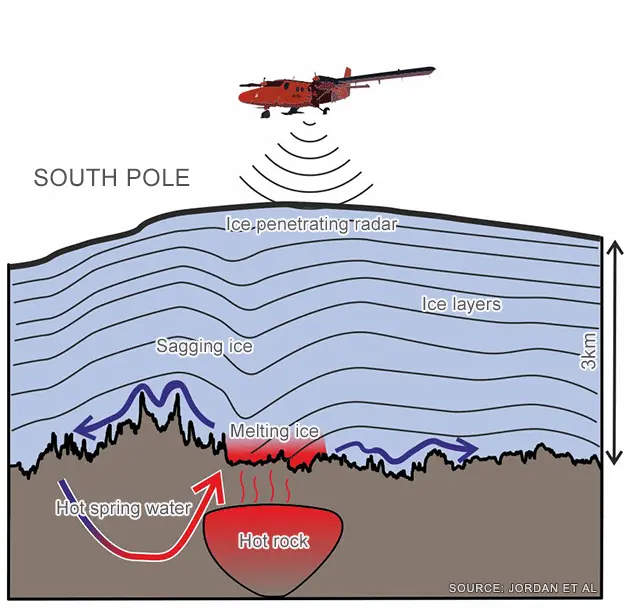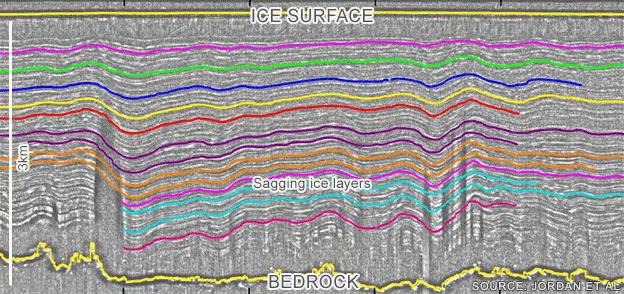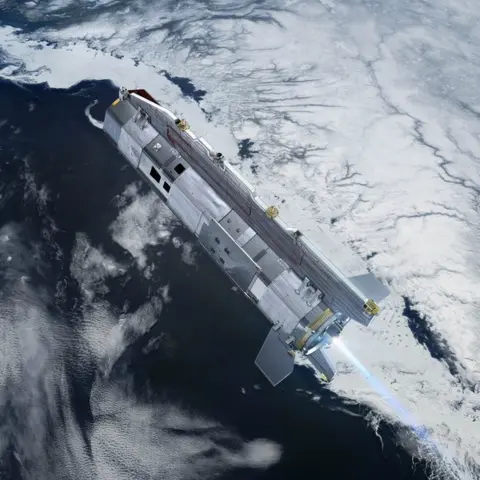South Pole: Rock 'hotspot' causes ice sheet to sag
 TOM JORDAN
TOM JORDANA "hotspot" is melting the base of the Antarctic Ice Sheet at the South Pole.
The area affected is three times that of Greater London.
Scientists suspect a combination of unusually radioactive rocks and geothermal springs may be responsible.
The warm bedrock is removing some 6mm a year from the underside of the 3km-thick ice sheet, producing a mass of meltwater that then flows away through sub-glacial rivers and lakes towards the continent's coastline.
The roughly 100km-by-50km hotspot came to light when researchers examined radar images of the ice sheet at 88 degrees South.
This revealed a startling sagging in the ice layers directly above the hotspot.
Dr Tom Jordan, from the British Antarctic Survey, and colleagues have detailed the discovery in the journal Scientific Reports.

Dr Jordan told BBC News: "We can't be 100% sure because we don't have access to the rocks, but our interpretation is that this heat is coming from granites that contain lots of radioactive elements, such as uranium and potassium. That makes them hotter than you would expect.
"But our calculations show this doesn't quite give you enough heat. I think there's a second process. The topography of the bedrock suggests there is faulting and that could allow hot water to circulate up through the rocks, like hot springs."
 SOURCE: JORDAN ET AL
SOURCE: JORDAN ET ALAntarctica is in no danger of melting away as a result of this hotspot.
In the grand scheme of things, the area affected and the amount of melting is simply too small to have a significant impact. But the knowledge adds to our understanding of the under-ice hydrology of the continent.
There is vast network of sub-glacial rivers and lakes in Antarctica and they influence the way the ice sheet moves above them.
Any attempt to model how the frozen landscape might respond to future climate warming has to take account of this water system.

The discovery also has a bearing on efforts to drill the most ancient ice on the continent.
Scientists are currently looking for places where they could core an unbroken record of snowfall going back more than 1.5 million years.
The air bubbles and dust trapped in this ice would provide key insights on the way Earth's atmosphere has changed through time.
But any drill site would have to avoid locations with enhanced basal heating because the melting will erase any climate record imprinted in the core.
 ESA
ESAThe new study is the latest result to come out of the PolarGAP project.
This was initiated by the European Space Agency with the primary objective of acquiring gravity measurements at the South Pole.
Esa's satellites do not fly directly over the bottom of the world, meaning there is always a hole in their data.
To retrieve the missing gravity information, Antarctic scientists were asked to run an instrumented aeroplane back and forth across the pole
But they used the opportunity to sense also the magnetism in the bedrock, and to profile the height and structure of the ice.
"It was an unexplored frontier where no-one had previously made these kinds of measurements, and that means we've been able to discover many new things," said Dr Jordan.
[email protected] and follow me on Twitter: @BBCAmos
